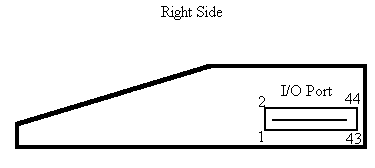Side (Peripheral) Port Pinouts


# Name I/O Use
- ---- --- -----------
1 VCC +5 Volts power supply
2 SBE > Low if addr in >9000-94xx (sound port)
3 RESET* > System reset (active low)
4 EXTINT* < External interrupt (active low)
5 A5 > Address bus, bit 5
6 A10 >
7 A4 >
8 A11 >
9 DBIN > Active high = read memory
10 A3 >
11 A12 >
12 READY < Active high = memory is ready
13 LOAD* < Unmaskable interrupt (=> BLWP @>FFFC)
14 A8 >
15 A13 >
16 A14 >
17 A7 >
18 A9 >
19 A15 > Address bus, lsb. Also CRU output bit.
20 A2 >
21 GND
22 CRUCLK* > Inversion of TMS9900 CRUCLOCK pin
23 GND
24 PHI3* > Inversion of phase 3 clock
25 GND
26 WE* > Write Enable (derived from TMS9900 WE* pin)
27 GND
28 MBE* > Active low if addr in >4000-5FFF (card ROMs)
29 A6 >
30 A1 >
31 A0 > Address bus, bit 0 (most significant)
32 MEMEN* > Memory access enable (active low)
33 CRUIN < CRU input bit to TMS9900
34 D7 <> Data bus, bit 7 (least significant)
35 D4 <>
36 D6 <>
37 D0 <> Data bus, bit 0 (most significant)
38 D5 <>
39 D2 <>
40 D1 <>
41 IAQ > Interrupt acknowledged by TMS9900
42 D3 <>
43 VDD -5 Volts power supply
44 AUDIOIN < To sound generator AUDIO IN pin
Keyboard connector: (inside the console) Red wire is #15
===================
pin| 12 13 14 15 9 8 6
---+-------------------------------------------------------------
5 | = . , M N /
4 | space L K J H ;
1 | enter O I U Y P
2 | 9 8 7 6 0
7 | fctn 2 3 4 5 1 lock
3 | shift S D F G A
10 | ctrl W E R T Q
11 | X C V B Z
Note: pressing a key closes the contact between corresponding row + column.
Since there are no diodes to prevent current going backwards, pressing 3
keys at a time often results in appearance of a "phantom" key at the 4th
corner of the square formed by these keys (e.g 8+7+3=phantom 4: current goes
pin15-7-8-3-pin7 as if 4 were pressed)